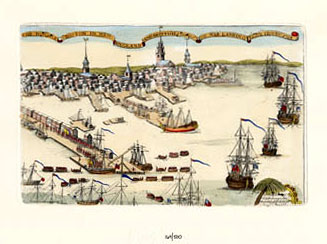Rediscovering the Prints of Paul Revere
 The Town of Boston and the Landing of the British Troops, 1768, copper-plated print by Paul Revere
The Town of Boston and the Landing of the British Troops, 1768, copper-plated print by Paul ReverePhotograph courtesy of the Museum of Fine Arts, Boston
Although most known for his famous "Midnight Ride" during the American Revolution, Paul Revere also left his mark as a metalsmith in the early 18th Century.
Revere had apprenticed with his father and eventually owned the silver shop that boasted his own name. He used his father's maker mark, and even shared patterns for casting handles and other parts. The senior Revere died in 1754, and when his son returned home within a year of service in the French and Indian War, he took over the shop along with its customers, tools, excellent reputation and even trained young men in the silversmith field.
In 1787, Revere opened his own foundry and Copper Mill in Boston's North End. The mill was financed with income from his silversmith shop and assistance from various relatives. Revere produced iron products, created bolts and spikes for the shipbuilding industry, cannon and bells. The foundry soon become a forerunner in the copper industry when Revere developed a mill for rolling copper. In 1800, Revere secured a federal government loan, to purchase and renovate a former gunpowder mill in Canton, Massachusetts for use as a copper rolling mill.
Motivated by patriotism and profit, Revere continued to learn new techniques, and soon became the first American to successfully roll copper into sheets. His customers included, among others, the federal government, who used copper in its naval vessels, the Commonwealth of Massachusetts who incorporated the copper in the dome of its new state house, and Robert Fulton, of steamship fame, who used heavy copper sheets for boilers on his steamships. And now, thanks to The Massachusetts Archives and Commonwealth Museum, his unique portfolio of engravings struck from an actual copperplate he created and engraved can now be viewed.
"We offer these in conjunction with the Commonwealth Museum," says Ellen Bragalone, Director of Operations at the Museum of Fine Arts, Boston. "They produced a limited edition (500) of three prints; two Paul Revere engravings and a copy of a soldier's pay record. The State Archives authorized this re-strike of Paul Revere's most significant original copperplates. The limited edition was inked by a master printer and hand-colored. These engravings actually represent two major occurrences in pre-revolutionary Boston - the Boston Massacre and the Landing of the British Troops."
Each portfolio is constructed of acid-free board and has an external navy-blue fabric cover sealed with an Italian silk ribbon. The front of the portfolio bears the content's title: The Paul Revere Portfolio - In Defense of American Liberty: Works That Changed America that are impressed into the coverplate of the portfolio in a classic gold script. The portfolio includes three engravings hand printed on 100% acid free cotton-rag paper. Every print is hand-colored with watercolors in period fashion, a hand-printed description in period letter press of each engraving, and a certificate of authenticity bearing the Great Seal of the Commonwealth of Massachusetts.
Resources:
Also in this Issue:
- Sculptor J. Seward Johnson, Jr.: Life, Cast in Bronze
- The Metal Peddler: Keeping Tradition Alive
- The Little Copper Cookie Cutter That Could
- Rediscovering the Prints of Paul Revere
- Baroque Sculptor Milton Hebald Returns to US for Harmon-Meek Exhibition
